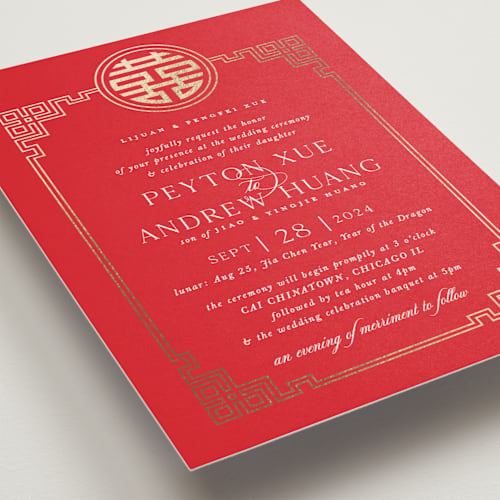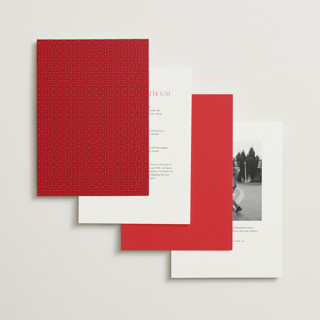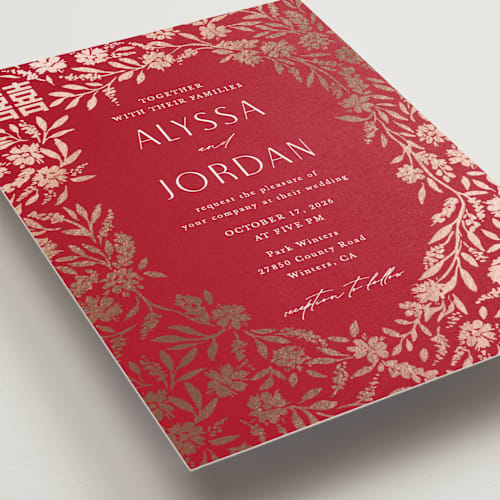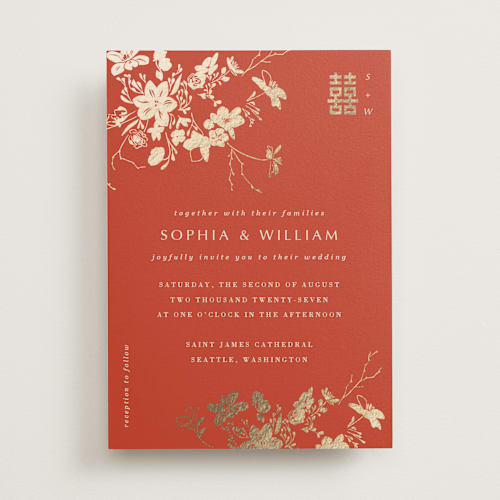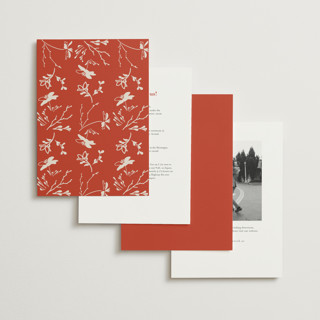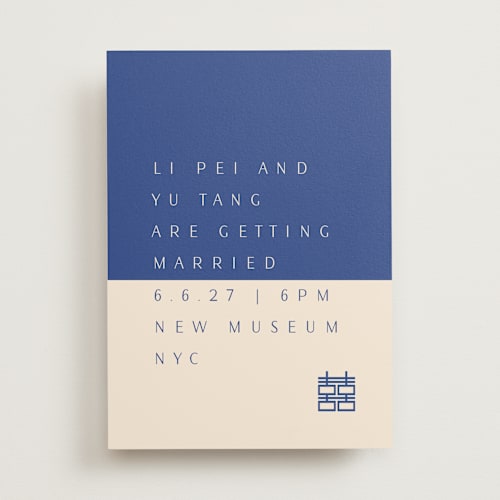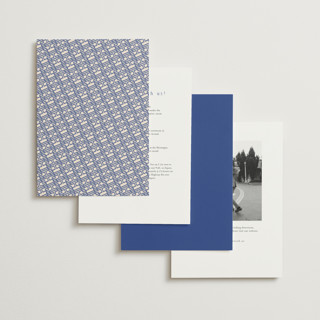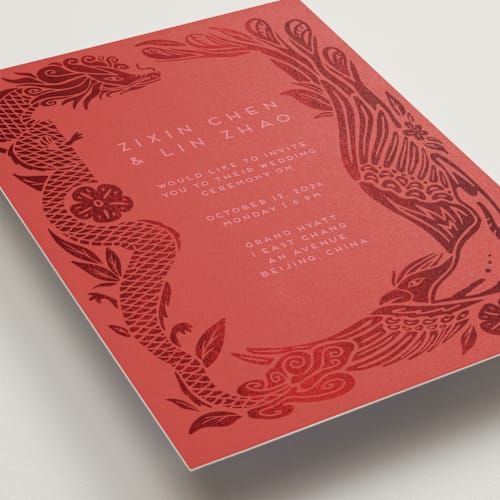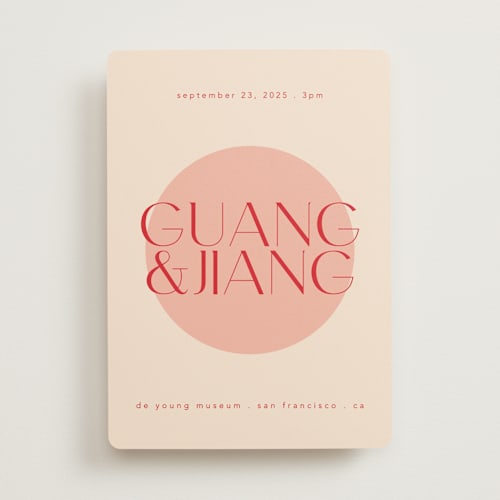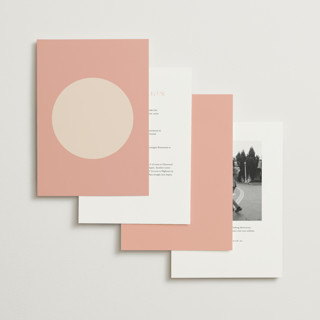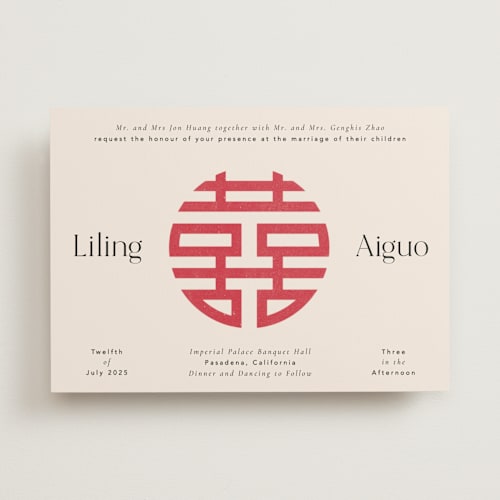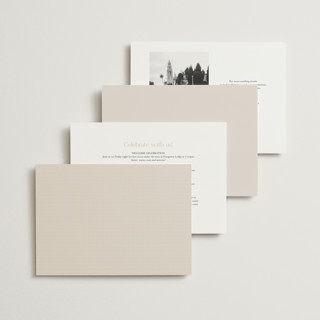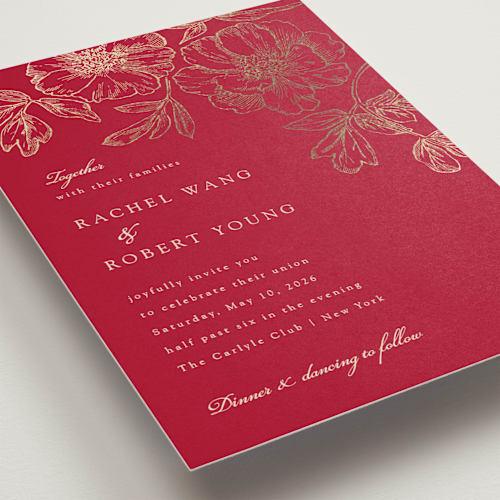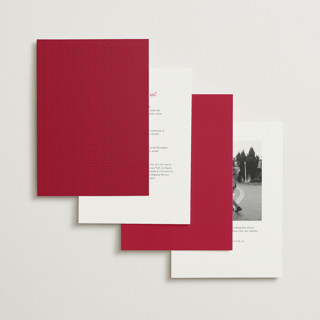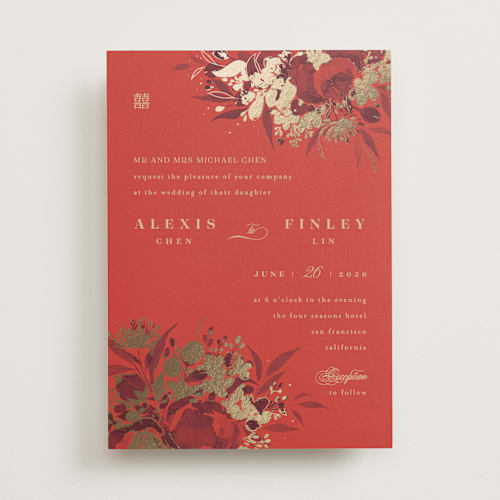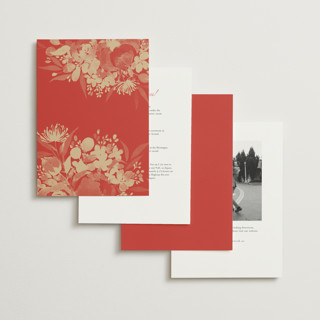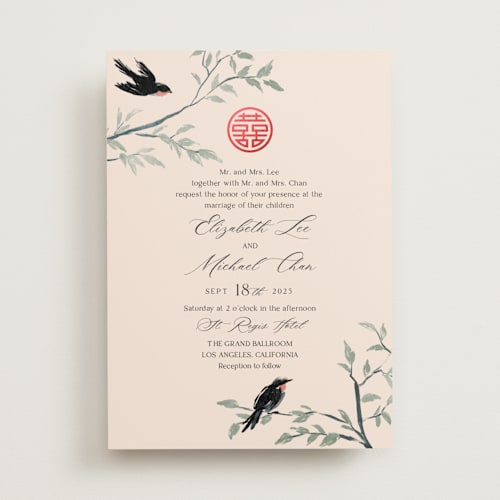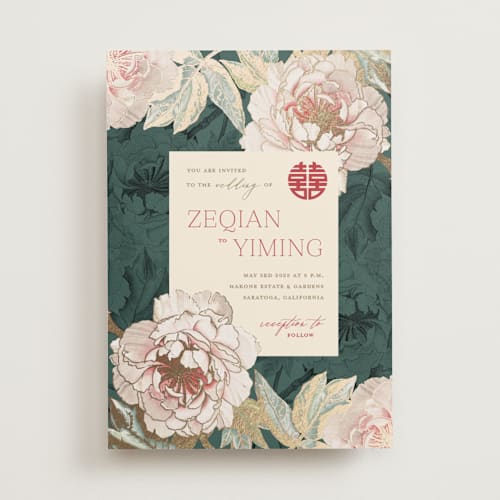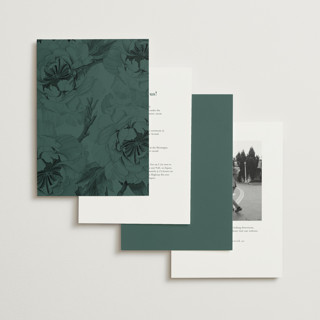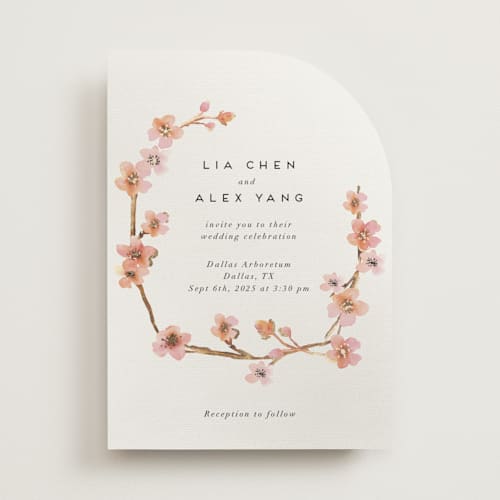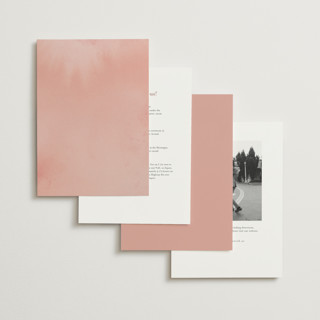Combining Traditional Chinese Elements with a Modern and Luxurious Feel
When it comes to planning a wedding that reflects your Chinese heritage and traditions, no detail is unimportant. And while your wedding invitation may not be the first thing you tackle on your wedding planning journey, it is one of the most important parts of your big day.
That’s because your wedding invitation will set the tone for your celebration—and because you want to incorporate meaningful Chinese traditions into your wedding details. Here’s what you need to know to ensure your wedding stationery contains all of the traditional Chinese wedding invitation details, while still reflecting your style as a couple.
Traditional Elements in Chinese Wedding Invitations
When it comes to wedding invitations, there are a few traditional Chinese design elements that couples should look to include, no matter their personal style. When picking the perfect design, pay attention to the details below:
- Red Invitation Envelopes: In Chinese culture, the color red symbolizes luck, joy, happiness, and celebration. Couples looking to root their ceremony in Chinese traditions typically opt to incorporate red into as many elements as possible during their day, including the envelopes they send their invitations in.
- Double Happiness Symbol: In addition to opting for a red invitation envelope, couples should look for envelopes that feature the “double happiness” “囍” character. Traditionally, this symbol should also be included within the design of the wedding invitation itself to communicate how excited you are to announce the upcoming wedding.
- Dragon & Phoenix Imagery: Chinese wedding invitations often feature beautiful illustrations of dragons and phoenixes alongside ceremony and reception details. The dragon is meant to symbolize the strength and wealth of the groom, while the phoenix is meant to symbolize the grace of the bride and her role as a renewer of life. Together, they communicate the love, happiness, and prosperity that the upcoming wedding will bring the couple.
- Mandarin Ducks: Though less common than dragon and phoenix imagery, many Chinese wedding invitations will also feature illustrations of mandarin ducks. In Chinese culture, mandarin ducks symbolize love and devotion, as these ducks are believed to be faithful lifelong partners to their mates.
- Red & Gold Color Palette: In addition to sending their wedding invitations in red envelopes, couples looking to incorporate Chinese traditions into their big day should select invitation designs that feature a rich color palette of red and gold. Typically, red is the primary color, with gold being reserved for design accents, such as the double happiness symbol mentioned above.
Elegant Takes on Chinese Wedding Invitations
Though couples should strive to include all of the traditional Chinese wedding invitation design elements we just covered, that doesn’t mean that they are limited to one single style or aesthetic! The options for how you incorporate these traditional symbols and colors are nearly endless, and can be customized to capture your unique essence as a couple. Here are a few of our favorite ways to put a personalized spin on your traditional Chinese Wedding Invitation.
- Foil-pressed: Because gold is used so prominently throughout Chinese wedding invitation designs, opting for a gold foil-pressed style is an easy choice for couples looking to dial up the elegance. For a more subtle—but no less glamorous—option, couples can also look for designs featuring red-foil accents, which can add a touch of luxury to more monochrome designs.
- Watercolor Flowers: To incorporate floral elements in a way ties into your traditions and heritage, look for invitations that feature beautiful watercolor flower designs as the medium is often associated with Chinese art. Lilies, orchids, peonies, and cherry blossoms are all options that further nod to classic elements of Chinese weddings.
- Sleek Fonts: The bold colors and graphic lines of traditional Chinese wedding invitation design elements work best when paired with sleek and simple fonts. Opt for invitation styles that feature clean typography that won’t compete with the other design elements like a more flowing script would.
- Photography: Want to feature a picture of you and your spouse-to-be on your invitation? Go for it! To keep things feeling traditional, opt for a photo of the two of you wearing traditional colors on a more neutral backdrop. This will ensure the photo ties into the red color palette that is sure to be featured elsewhere in your invitation design, while still providing some nice visual contrast.
Top 5 Traditions in Chinese Wedding Invitations
In addition to understanding the traditional design elements of Chinese wedding invitations, couples should also make sure they have a good sense of the traditions that surround invitation wording, timing, and delivery. Here are the 5 most important things you need to know:
- Invitation Wording:Whether you opt to send your invitations in Chinese or English (or a combination of the two), there are a few key things that your invitation wording must include.
- The family title and name of the guest. Show respect for your guests—especially your elders—by using formal titles and honorifics when addressing them. For example, if you are addressing your invitation to your grandfather, it should begin with “Dear Grandfather.”
- Indicate if you are inviting the guest’s spouse or whole family. Your invitation should make it clear what members of your guests’ household you would like to attend your big day. If their spouse is invited, the invitation should also include their title, name, and relationship to your guest.
- The wedding date in both the Gregorian Calendar and the Lunar Calendar. Wedding dates are not typically chosen at random by Chinese couples—that is because there are traditionally lucky and unlucky months to wed. Be sure to show you’ve honored this tradition by including both versions of the date.
- Names of the bride and groom. Typically, the name of the groom is listed before the bride in Chinese wedding invitations. It is also traditional to list the couple’s name in birth order, in which case, the older party should be listed first.
- Invitation Timing: If you are following Chinese traditions, invitations should be sent after you host your Engagement Ceremony or Guo Da Li. This means that your invitations should be sent to guests about 3 months before your big day.
- Invitation Delivery: Traditionally, wedding invitations to the family members of the couple getting married should be sent by their parents. Ideally, these invitations will be delivered in person as a sign of respect (though mailing them is definitely OK if your family is spread across the country or globe). Invitations to friends and colleagues can be sent by the couple directly.
- Wedding Cake Cards for the Bride’s Guests: Traditionally, wedding cakes are sent to the bride’s family from the groom’s as part of the engagement gift and ceremony. These cakes would then be shared with the bride’s friends and extended family to allow everyone to share in her happiness. Today, many couples skip sending physical cakes to the bride’s family and friends, and instead include wedding cake gift cards within the invitation suite.
- Red Packet Gifts for the Groom’s Guests: This tradition traces its roots back to the Chinese proverb “courtesy demands reciprocity.” To say thank you in advance for the red envelope gifts the couple will receive on their big day, the groom’s family will sometimes send red envelope gifts with a small amount of cash to their guests with the wedding invitation. (It is also a good idea to send red packets to any guests unfamiliar with Chinese wedding gift traditions!) Alternatively, some couples may give out red packets to guests at the reception. Note that gifting red envelopes is completely optional, so budget-conscious couples shouldn’t stress about including this if it means sacrificing elsewhere.
Chinese Wedding Invitation Suites
In addition to including wedding cake cards for the bride’s guests and red packet gifts for the groom’s, Chinese wedding invitations suites should include an invitation to the tea ceremony.
The tea ceremony is a key part of Chinese wedding traditions, and usually happens the day of the wedding ceremony. Typically, the bride and groom serve tea to their parents, in-laws, and other family members as a symbol of the union between the two families. Bridesmaids will also normally be present to help serve the tea.
All of Minted’s Chinese wedding invitation suites also feature a coordinating design for the tea ceremony invitation, which should be sent to close family members such as parents, grandparents, aunts, and uncles. Most of the enclosure card designs can also be customized and used as the tea ceremony invitation.
Wedding Invitation Customization
Minted provides custom design services if you’re looking for an invitation suite that is as unique as you are. If you go this route, you’ll be paired with one of our in-house designers. Your designer will work closely with you to ensure your vision is brought to life flawlessly—whether it be adding original illustrations of your venue, creating a custom watercolor scene, or creating a layout that accommodates text in English and Chinese to support a bilingual ceremony.
Get started by submitting your ideas through our initial request form today!
Free Samples of Your Chinese Wedding Invitations
Not sure if modern red foil-press will look better than more traditional gold foil on your invitation? Or do you want to see what type of cardstock will look best in red? Minted offers a variety of free sample options to help ensure you make the absolute right choice.
If you’re at the very beginning of your invitation selection journey, we recommend ordering our Free Sample Kit, which includes samples of a variety of our standard, foil-pressed, and letterpress invitations, plus swatches of our premium paper options, envelope colors, and more.
Or, if you’re trying to choose between your two favorite designs, you can order a sample of the two styles to be able to compare and contrast in person.
Read less ▶︎




